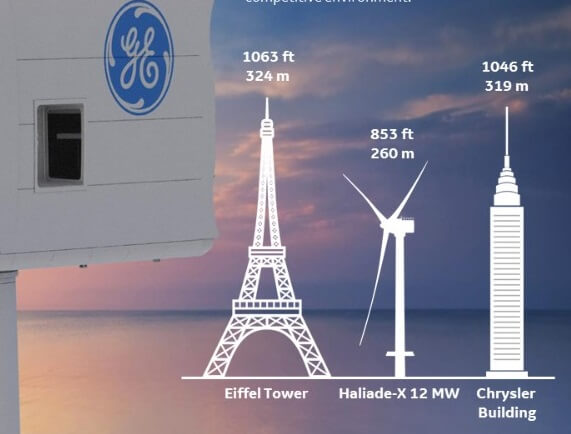How To Describe Today’s Offshore Wind Turbines? In a Word: BIG

There are some compelling reasons that big works so well for offshore. One is aesthetics. I happen to like the look of turbines, especially insofar as I know the good they’re doing in cleaning up the environment. But not everyone feels that way, and most folks would admit that big devices are more intrusive visually, thus less suited for onshore locations.
Yet that consideration is minor in comparison to the mathematics of costs, which my colleague Gary Tulie described well in this passage he contributed on offshore wind for my 2015 book Bullish on Renewable Energy:
With offshore wind, technologies are less mature and costs are higher, but they are declining faster due to being at an earlier stage in the learning curve.
The optimum size here appears to be over 6 MW; MHI Vestas has commercialised an 8 MW turbine with a 164 meter sweep. Few people realize how big this is; the swept area of this turbine is equal to three soccer fields.
Future turbines are expected to get even larger as foundations, cable connections, and O&M all form a far larger component of levelised cost of electricity than onshore; larger turbines mean fewer foundations, fewer cable connections, and fewer units to maintain.
This being the case, a larger turbine, even if its cost per kW is higher, can be cost-effective if the extra turbine costs are offset by greater savings elsewhere in the overall wind farm package. Foundations, cabling, and O&M only increase slightly with larger offshore turbine size, so the industry demands ever larger turbines. Thus, higher towers, larger generators and longer blades become an attractive means to lower levelised cost of electricity.
Prototype wind turbines rated at 10 MW are at an advanced stage of design, and likely to begin deployment shortly, whilst even larger turbines up to 20 MW are at the early research concept stage. It remains to be seen how big offshore turbines will eventually get but it is a fair assumption that those over 10 MW will eventually become the norm for this market segment.
Within the offshore wind industry, there is an emerging subsection of floating wind turbines. With fixed offshore wind turbines, there is a limit to viable water depth which limits suitable sites to areas with water depth up to around 30 meters. Floating designs allow deeper waters to be exploited, greatly increasing the number of potential sites for offshore wind power, and allowing the turbines to be placed further out to sea in areas with better wind resources.
With further R&D and volume production, it is likely that floating wind farms can match, or possibly even better the costs of fixed offshore wind power.
So good to see this coming along.

Craig,
“So good to see this coming along”, well if you’re a one eyed ardent advocate for a heavily subsidized wind industry or turbine manufacturer, I suppose it’s “So good to see this coming along”.
Whether this is good for the environment or an efficient method of generating power is another matter.
Have you ever taken a moment to consider the downsides of these installations ?